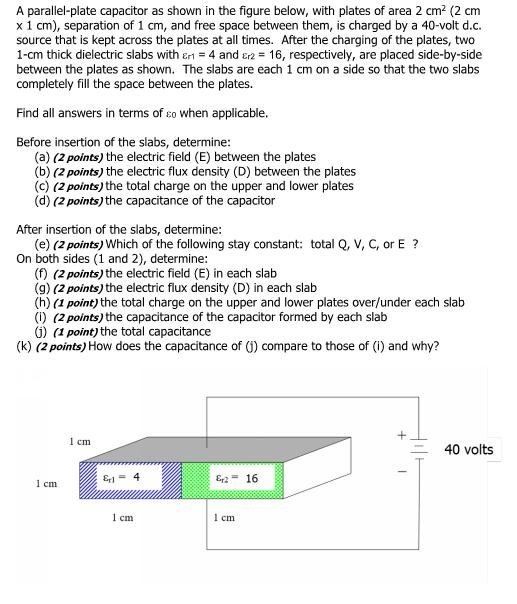Answered step by step
Verified Expert Solution
Question
1 Approved Answer
A parallel-plate capacitor as shown in the figure below, with plates of area 2 cm (2 cm x 1 cm), separation of 1 cm,

A parallel-plate capacitor as shown in the figure below, with plates of area 2 cm (2 cm x 1 cm), separation of 1 cm, and free space between them, is charged by a 40-volt d.c. source that is kept across the plates at all times. After the charging of the plates, two 1-cm thick dielectric slabs with n = 4 and 2 = 16, respectively, are placed side-by-side between the plates as shown. The slabs are each 1 cm on a side so that the two slabs completely fill the space between the plates. Find all answers in terms of co when applicable. Before insertion of the slabs, determine: (a) (2 points) the electric field (E) between the plates (b) (2 points) the electric flux density (D) between the plates (c) (2 points) the total charge on the upper and lower plates (d) (2 points) the capacitance of the capacitor After insertion of the slabs, determine: (e) (2 points) Which of the following stay constant: total Q, V, C, or E ? On both sides (1 and 2), determine: (f) (2 points) the electric field (E) in each slab (g) (2 points) the electric flux density (D) in each slab (h) (1 point) the total charge on the upper and lower plates over/under each slab (1) (2 points) the capacitance of the capacitor formed by each slab (j) (1 point) the total capacitance (k) (2 points) How does the capacitance of (j) compare to those of (i) and why? 1 cm 1 cm 14 1 cm E2 16 1 cm + 1 40 volts
Step by Step Solution
There are 3 Steps involved in it
Step: 1
Before insertion of the dielectric slabs a The electric field E between the plates can be calculated using the formula E Vd where V is the voltage and d is the separation between the plates In this ca...
Get Instant Access to Expert-Tailored Solutions
See step-by-step solutions with expert insights and AI powered tools for academic success
Step: 2

Step: 3

Ace Your Homework with AI
Get the answers you need in no time with our AI-driven, step-by-step assistance
Get Started


